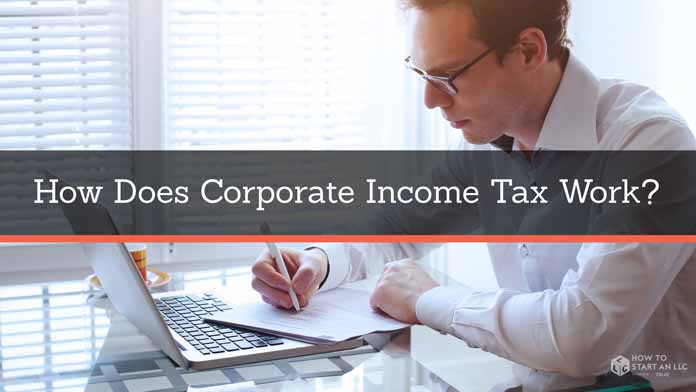How Does Corporate Income Tax Work?
The corporate income tax pertains to corporations, along with LLCs that elect to be taxed as a C Corp, which is the standard tax structure for corporations. The current corporate tax rate is 21% and it is applied to all business profits. Throughout this article, we’ll take you through a brief history of corporate taxation and explain how corporate income taxes work according to your business’s unique characteristics.

A Brief History of Corporate Taxation
Corporate taxes began in the United States in 1909 at a rate of 1% on profits over $5,000. The rate trended upward into the teens over the next 30 years, expanding into multiple brackets across corporate income levels. The rate grew rapidly in the 1940s to help fund World War II, with the top rate jumping from 24% in 1940 to 40% in 1945. It continued its rising trajectory through the 1950s and 1960s, peaking in 1968 at 52.8% for the highest bracket.
From there, rates began to slowly decline, hitting 40% in 1980 and 34% by 1987. In 1993, the top corporate tax rate was increased by one point to 35%, where it remained for the next 24 years. In 2017, the Tax Cuts and Jobs Act reduced the corporate tax rate to a flat rate of 21%, the lowest it’s been since 1939.
A Corporation is the Only Type of Business Taxed
While corporations have been paying federal taxes in the U.S. for over 100 years, other business structures are not obligated to do so. Partnerships, LLCs, and S corporations are all classified as “pass-through” tax entities by the IRS. This means that the profits of the business pass through to its owners, who then pay personal income taxes on their share.
Quarterly Tax Payments
The IRS requires corporations to pay quarterly estimated income tax if the business expects its total tax for the year to be $500 or more. The due dates for these payments are April 15, June 17, September 16, and December 16. The amount due is based on your estimated total annual gross income, deductions, and credits. Failure to pay estimated taxes can result in a penalty when you file your return.
Double Taxation
Corporations distribute their profits to shareholders in the form of dividends. Shareholders then have to pay personal income tax on these dividends. Because the profits of the company have already been taxed at the corporate level, corporations are said to be “double taxed.” The tax rate on ordinary dividends is the same as the individual federal income tax rate, which means it will vary depending on your income.
Types of Tax-Deductible Expenses
While corporations are subject to federal income tax, it is possible to lower your company’s tax obligation by deducting certain eligible business expenses. Here are some examples of things you may be able to deduct.
- Rent
- Equipment
- Employee pay
- Retirement plans
- Insurance
- Interest
- Travel
- Other taxes (e.g., sales, unemployment, property)
Retained Earnings
Retained earnings (or, as the IRS calls them, accumulated earnings) are profits that companies keep for business use after distributing dividends to shareholders. While these earnings have been taxed at the corporate level under federal tax requirements, they are not taxed a second time, unless they are eventually distributed to shareholders or as compensation to employees. This means that retained earnings can potentially decrease the total amount of tax paid on corporate earnings, as long as the money is invested back into the company. Some of the things that retained earnings can be used for include:
- Acquisitions
- Debt payments
- Insurance payments
- Expanding the business
- Making loans
What Are Fringe Benefits?
Fringe benefits are non-cash compensation to a company’s employees. A corporation can deduct the value of these benefits from its total taxable income. Fringe benefits can include a lot of things, but some of the most common include:
- Health insurance
- Transportation costs
- Education costs
- Housing costs
- Relocation costs
- Retirement plans
- Gym or other memberships
S Corporation: Pass-Through Taxes
While the names are similar, S corporations and C corporations are quite different. While C corps are subject to corporate income tax, S corps are not taxed at the corporate level. Instead, the company’s income passes through to its shareholders, who then pay personal income tax on their share of the profits.


